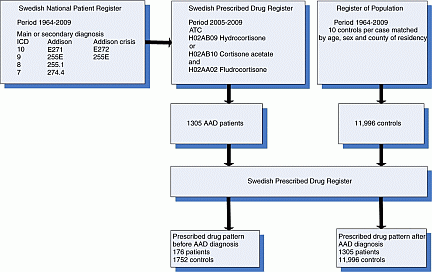ICEECE2012 Poster Presentations Adrenal cortex (113 abstracts)
Drug prescription pattern in patients with autoimmune addison’s disease in Sweden
S. Björnsdottir 1 , A. Sundström 1 , P. Blomqvist 1 , O. Kämpe 2 & S. Bensing 1,
1Karolinska Institutet, Stockholm, Sweden; 2Uppsala University, Uppsala, Sweden.
Introduction: There is no published data on dispensed drug pattern in patients with Autoimmune Addison’s disease (AAD). Sweden has excellent condition for research in this area, with high-quality population based registers. Among them is the Swedish Prescribed Drug Register (SPDR) that contains information about dispensed prescribed drugs. By linking registry data, we aimed at accurately estimate the prevalence and incidence of AAD, the prevalence of common concomitant autoimmune manifestations and to describe the drug prescription pattern in Swedish patients with AAD.
Methods: Through the Swedish National Patient Register (SNPR) and the SPDR we identified 1305 patients with an AAD diagnosis and combination treatment with hydrocortisone/cortisone acetate and fludrocortisone. Through the Total Population register we identified 11,996 age- and sex- matched controls. Dispensed drug prescription pattern according to the SPDR was analyzed in AAD patients and controls.
Results: The mean age at AAD diagnosis was 42.2 years (standard deviation (S.D.), 16.9) for women and 35.4 years (S.D. 16) for men. 54% were female and 46% male. The prevalence of AAD during the period 2005–2009 was 12.2–13.1 (P for trend 0.062) and the incidence 0.5–0.6 (P for trend 0.131) per 100,000 inhabitants per year. 59.3% of AAD patients had medications indicative of concomitant major autoimmune polyendocrine syndrome manifestations, 46.6% autoimmune thyroid disease, 17.7% B12 deficiency and 14.2% type 1 diabetes mellitus. The mean number of concomitant dispended drugs was 11.6 (S.D. 10.0) in the AAD group and 9.6 (S.D. 8.6) in the control group (Difference in mean 2.1 (95% CI 1.5–2.6), P<0.0001). After diagnosis, AAD-patients were dispensed more gastrointestinal medications, vitamins, mineral supplements, osteoporosis drugs, antihypertensive drugs, lipid modifying agents, sex hormones and urological drugs, anabolic steroids, anti-infectives, immunosuppressants, analgesics, hypnotics and sedatives, antidementia drugs, drugs for obstructive airway diseases and opthalmological preparations.
Conclusion: The incidence and prevalence of AAD in Sweden is comparable to the high figures reported from Norway. Patients with AAD have a higher number of dispended drugs compared to controls. The drug prescription pattern is partly expected but also raises concern about the morbidity of patients.

Declaration of interest: The authors declare that there is no conflict of interest that could be perceived as prejudicing the impartiality of the research project.
Funding: This research did not receive any specific grant from any funding agency in the public, commercial or not-for-profit sector.
 }
}



